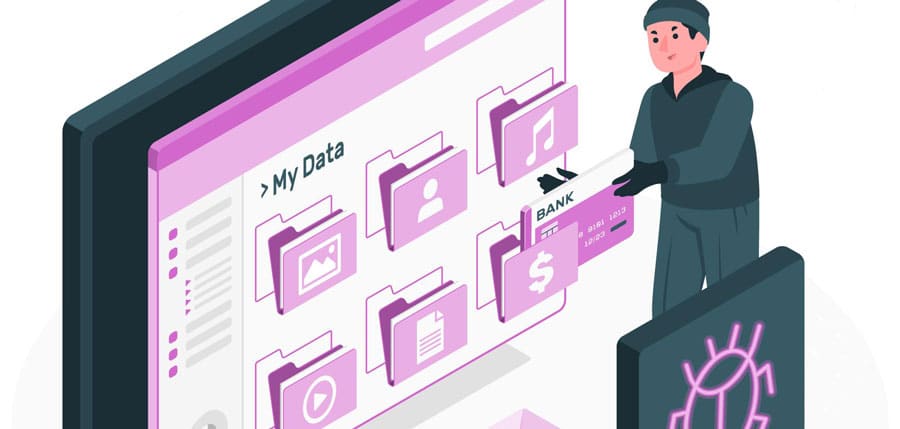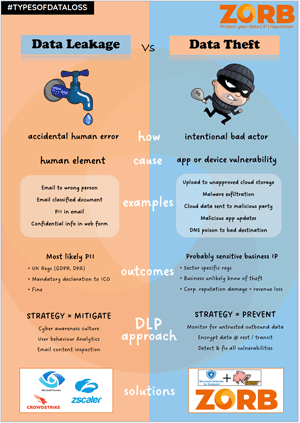Data Theft or Leak? Why the Differences are Important
Quick Summary → Data loss, data breach, data leakage, data theft. We use these terms interchangeably, but they actually do refer to different events. This difference is important, as for each, the risk is different and requires a different prevention strategy to protect your business data.

Image courtesy of storeyset on Freepik
Personal Identifiable Information v Intellectual Property
Before defining the different data terms, it is necessary to understand that businesses generally have two categories of data:
-
- Personal Identifiable Information (PII) – such as email addresses, telephone numbers, credit card details, social security details, religion.
- Intellectual Property (IP) – such as customer lists, financial statements, trade secrets.
PII is legally protected by country-defined Data Protection Acts. In the EU, GDPR outlines the processing of personal data of individuals, regardless of the organisation’s location. In the UK we have UK GDPR which is a domestic version of GDPR adopted after the UK left the EU. We also have the DPA 2018 alongside UK GDPR to address specific UK requirements not covered by GDPR. Any UK business that believes they may have disclosed PII to an unauthorised body is legally obliged to notify the Information Commissioner’s Office of a potential breach.
Proprietary Intellectual Property protection is not mandated. Nor is there a legal requirement to declare this type of data loss unless industry-specific regulations insist. However, the consequences of loss of this type of data can be severe. It can lead to financial loss, corporate reputation or brand impact, or organisational downtime.
The differences in these two data categories are explored in more detail here.
Loss, Breach, Leak, Theft: Understanding the Differences
Data Loss
Data loss is an umbrella term used to describe unintentional (data leak) or deliberate (data theft) exposure of data. This could be data held on a device, on a network or in the cloud.
Undoubtedly data loss can have negative impacts. But the opposite is also true. Many studies have shown a link between increased demonstrable data protection and increased customer loyalty. Hence, businesses often show their commitment to customer data protection through certifications such as Cyber Essentials, or larger businesses might consider a framework such as ISO27001.
Data Breach
A breach occurs when access to sensitive data is gained within a secure perimeter, by either an unauthorised person or an unauthorised application such as malware. Even if the data is not exfiltrated. A breach can involve PII or Intellectual Property. A breach only becomes data loss when data has been removed from its secure holding.
Data Leakage
Data leakage is the unintentional, accidental disclosure of data, usually due to human error. Typically, this is PII data emailed to an unintended third party, a social post, or a web forum. The primary cause of data leaks is a user’s lack of understanding of data protection.
Data Theft
Data theft is the intentional, deliberate attempt to exfiltrate data. Typically, this is theft of valuable business proprietary Intellectual Property. The objective of data theft is to sell the data on the dark web, to exploit the data or an individual, or to sabotage the company. Or it could simply be to cause disruption. Theft opportunities occur from vulnerabilities or misconfigurations in hardware or software. Data theft has traditionally been via hackers, for resale of the data on the dark web. Today we are increasingly seeing politically motivated, or state-sponsored data theft. Another source of data theft is disgruntled employees.
Personal Protection: Data Leakage Prevention Strategies
Data leaks can be mitigated through user training and a strong cyber awareness culture within a company. This includes awareness of phishing emails, social engineering attacks, clickjacking attacks, ransomware attacks. As well as understanding why users should use VPN, etc. Application-specific mitigation comes from content-filtering Data Loss Prevention software. Such as Microsoft’s Purview, which monitors the content of emails for PII disclosure. User Access Control methods can be used to restrict the data that individual users can access.
Learn more about data leakage prevention techniques.
Business Reputation Protection: Data Theft Prevention Strategies
Data leakage can be MITIGATED. But mitigation comes too late in a cyber kill chain for data theft. Instead, when it comes to data theft, the emphasis is on PREVENTION.
Data theft prevention, or indeed elimination, requires the continuous monitoring of outbound data to block any exfiltration attempts before they become a cyber breach. Without monitoring outbound traffic, businesses remain unaware that data has been stolen. The first warning could be when their competitor starts to undercut them in every deal.
Data encryption is often cited as a breach-prevention technique. It is highly recommended to encrypt both data stored on devices or USB (eg using Microsoft’s BitLocker) and data being sent over the Internet such as email, cloud application data, etc. (eg using VPN). Encryption itself does NOT stop theft. The idea behind encryption is to make it incredibly hard (maybe not impossible) for a bad actor to read stolen data.
Learn more about data theft prevention techniques.
What’s the worst that can happen? Real-world Data Loss Examples
Breach – Equifax
Probably the most well-known data breach is the 2017 cyberattack on Equifax, a credit reporting agency. Over 147 million PII data records were exposed, including names, addresses and social security numbers. A congressional hearing resulted in a $700 million compensation settlement for the victims. Additionally, Equifax’s stock dropped 31% post-breach.
Leak – Police Service of Northern Ireland
In 2023, the names of 10,000 Northern Irish police employees were accidentally leaked in a freedom of information response. The repercussions were not only severe corporate reputational damage and loss of public trust but may have impacted the lives of serving police officers. This leak occurred weeks after the theft of a police-issue laptop containing the names of 200 staff stolen, and a police-issue laptop falling from the roof of a moving police vehicle.
Theft – LastPass
The most recent, high-profile data theft was of a LastPass password vault data. In a highly targeted attack, a vulnerability in a third-party application gave attackers access to a developer’s device whilst working from home. The theft has been linked to a crypto heist with almost $35 million having been stolen from victims.
Conclusion
Any business that strives to have a robust data protection strategy needs to understand the different data loss nomenclatures. Ultimately data loss prevention requires a holistic approach to both leakage and theft prevention techniques. Each requires a slightly different approach and neglecting one over the other could turn a data breach into a data loss.
Put ZORB to the test
14 DAY RISK-FREE TRIAL
See first hand how ZORB protects sensitive data,
blocks data exfiltration and safeguards your business reputation.
No credit card required



